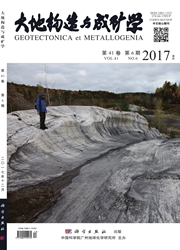

 中文摘要:
中文摘要:
浙西开化地区皖浙边界断裂带西侧浅变质岩系中发育了一套以流纹岩为主的酸性火山岩。两个流纹岩样品的锆石LA-ICP—MSU-Pb定年分别给出了785±5Ma和781±10Ma的结果,显示为南华裂谷期的产物。岩石地球化学分析显示:该流纹岩富硅偏碱,铝饱和指数A/CNK大于1.11,显示过铝质特点;稀土元素总量高,相对富集轻稀土元素,具中等Eu负异常;相对富集Rb、Th、U、Pb等强不相容元素,而相对亏损亲石元素Ba、Sr、Nb、Ta,Zr含量较高。与壳源花岗质岩浆的地球化学特征相似。在微量元素构造判别图中显示为板内火山岩。结合地质背景分析,认为其形成于大陆裂谷环境,可能与华南地幔柱活动有关。
 英文摘要:
英文摘要:
A set of felsic volcanic rocks, dominantly rhyolites, occurs in the low-grade metamorphic rock series along the fault zone near the boundary of Anhui and Zhejiang provinces. LA-ICP-MS zircon U-Pb dating of two Kaihua rhyolites yielded 785±5 Ma and 781±10 Ma respectively, consistence with the time of supercontinental rifting in South China. The rhyolites are enriched in alkali and silicon, with aluminum saturation index A/CNK greater than 1.11. They have high REE content, relative enrichment of LREE and highly incompatible elements like Rb, Th, U, Pb, and moderate negative Eu anomalies, as well as the relative depletion of lithophile elements such as Ba, Sr, Nb, Ta. All the geochemical characteristics of the rocks suggest a crustal origin. In the trace element discrimination diagrams, they fall within the intra-plate volcanic rock array. Regarding the geological backgrounds, it can be concluded that the rhyolites were formed in continental rift environment associated with the activity of the mantle plume in South China.
 同期刊论文项目
同期刊论文项目
 同项目期刊论文
同项目期刊论文
 期刊信息
期刊信息
